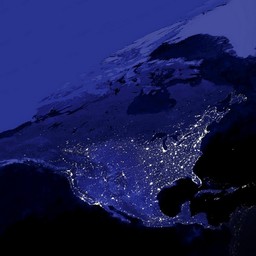3. The Earth is inhabited unevenly
Contents
3.1 How was the Earth inhabited?
Modern humans originated from Africa. From there, humans first spread to Europe and Asia, before expanding further into Australia and America tens of thousands of years ago. The indigenous peoples of Australia and the Americas are the descendants of these ancient migrants.
Stone age humans arrived in Australia approximately 50 000 years ago. They are the ancestors of the modern-day Australian aboriginals. Europeans arrived in Australia during the 1600s.
 Australian aboriginals in traditional clothing.
Australian aboriginals in traditional clothing.
Indigenous people of the Americas are the descendants of humans who arrived in America tens of thousands of years ago. These people arrived at the continent from Asia via the Bering strait. This was possible because the sea levels were significantly lower tens of thousands years ago than they are today.
The Native Americans of North America spread across the continent over a time frame of thousands of years. They lived in hundreds of small groups or tribes, each of which had their own cultures, customs, and languages.
Many Native American tribes consisted of hunter-gatherers that moved from place to place in search for food. The first Native American cities were formed in the Mississippi valley during the 8th century. However, the most advanced civilizations in America formed in Central and South America. These advanced civilizations, the Maya, the Aztecs, and the Inca, were as culturally advanced and nuanced as the ancient advanced civilizations of Egypt and Mesopotamia.
Other Native American peoples include the northern Inuits and Yupiks. These peoples inhabited the coast and archipelago of the Arctic Ocean all the way to Greenland.

America was first inhabited via the Bering Strait tens of thousands of years ago. European settlers arrived in America in the 15th century.
3.2 European migration transformed the continents
 When knowledge about the "new world" that was to be found on the other side of the Atlantic arrived in Europe in the 16th century, an era of Europan migration to America began.
When knowledge about the "new world" that was to be found on the other side of the Atlantic arrived in Europe in the 16th century, an era of Europan migration to America began.
People from Southern Europe, especially Spain and Portugal, settled in Central and South America, whereas people from Western and Northern Europe migrated to North America.
These settlers were searching for a better life on the naturally rich American continents. They brought their languages, cultures, customs, and architectures together with them, and transformed the landscape of the two continents drastically. This often took place at the cost of the indigenous inhabitants, whose populations greatly diminished as the European population in the Americas grew.
North and South America can be divided culturally into northern Anglo-America and southern Latin America based on the ethnicity of the European settlers that inhabited the two continents.
The cultural region of Anglo-America consists of the North American nations of the United States and Canada. These nations formed in the regions that were originally settled by British, French, and Spanish colonists. English is the most widely spoken language of the Anglo-American cultural region, with the exception of the Canadian province of Quebec, which is French-speaking.
 The European expansion to North America has a dark undertone. During the 17th century, approximately 400 000 – 600 000 slaves were brought from Africa to work as manual laborers in the fields of the new world. Many of these people died of sickness during the journey through the Atlantic. They had no rights and were considered the property of the European colonists. The slave trade, together with the genocide of the Native American people, cast a dark shadow over European migration to North America.
The European expansion to North America has a dark undertone. During the 17th century, approximately 400 000 – 600 000 slaves were brought from Africa to work as manual laborers in the fields of the new world. Many of these people died of sickness during the journey through the Atlantic. They had no rights and were considered the property of the European colonists. The slave trade, together with the genocide of the Native American people, cast a dark shadow over European migration to North America.
The cultural region of Latin America includes all the nations of Central and South America. The inhabitants of Latin America are descendants of Spanish and Portuguese settlers and the indigenous peoples of the region. Spanish is the most important language in Latin America, spoken in almost every Central and South American country except for Portuguese-speaking Brazil.
Latin America also received its share of the slave trade. Approximately 4–5 million slaves were brought to work in the sugar plantations of the West Indies, whereas over 3 million slaves were imported to Brazil.
Migration to the Americas continues to this day. Especially the rich nations of North America receive migrants from all around the world, making these nations exceptionally diverse.
Photograph: Lionel Messi is an Argentinian football player whose ancestors were European migrants. Spanish is the majority language of Argentina, which made it easy for Messi to move to Spain to pursue his career as a professional football player.
3.3 Population density
 The population density of a region is measured by counting the number of people that live per each square kilometer of surface area in the region. The average population densities of nations do not reveal the population densities of different regions accurately. This is due to the fact that population density varies greatly between different areas.
The population density of a region is measured by counting the number of people that live per each square kilometer of surface area in the region. The average population densities of nations do not reveal the population densities of different regions accurately. This is due to the fact that population density varies greatly between different areas.
For example, the average population density of Egypt is 82 inhabitants per square meter. However, the Nile valley alone has a population density of over a thousand people per square kilometer. This population density is significantly lowered by the desert areas of Egypt, which are largely uninhabited.
Image on the right: The satellite image shows how habitation is centered along the river Nile in Egypt.
The Earth has plenty of space for humans, but the conditions for permanent inhabitation vary greatly between different areas. Over one third (40%) of Earth's land surface area is uninhabitable. These uninhabitable areas consist of frigid polar regions and Antarctica, deserts, high mountain ranges, and thick rainforests.
Approximately 80 % of Earth's population lives at elevations below 500 meters. Earth's population is concentrated on the shores of bodies of water, such as seas, rivers and lakes. The majority of the planet's population is based in the northern hemisphere.

Click the picture three times to expand it! Describe the population distribution on planet Earth.
3.4 Population centers
Every continent and nation has its own population centers. These population centers are where the majority of a regions inhabitants are based.
The largest and most dense urban areas of the planet accommodate over 10 000 people per square kilometers. The largest urban areas on the planet are called metropolises. They are cities with a population of over 1 million people.
Currently, planet Earth has five large-scale population centers: the eastern parts of North and South America, Western Europe, as well as East and South Asia.
3.5 Population centers in satellite images
Summary
 The Native Americans inhabited North and South America tens of thousands of years ago. They arrived in America from Asia via the Bering strait.
The Native Americans inhabited North and South America tens of thousands of years ago. They arrived in America from Asia via the Bering strait.- The Americas were transformed by European migration.
- The cultural region of Anglo-America formed as a result of British and French migration to North America.
- The cultural region of Latin America formed as a result of Spanish and Portuguese migration to Central and South America.
- The most densely populated areas on Earth are concentrated near the shores of bodies of water.
- Most of Earth's population is nowadays concentrated in Asia.









